Planting for shade can be challenging enough; combine shade with soil that remains moist or even wet year-round, and it's enough to make even an experienced gardener shudder.
Yet there are some stunning perennials, shrubs and even trees that revel in such conditions — indeed requiring moisture-retentive soil to thrive. This garden has been transformed into a cool, leafy glade through a combination of soothing colors and contrasting textures. A path weaves through the space to an inviting bench, with waterfalls of soft grasses softening the lines.
Thoughtfully placed containers become focal points along the way, either left unplanted as sculptural elements or filled with water to add an additional layer of interest.
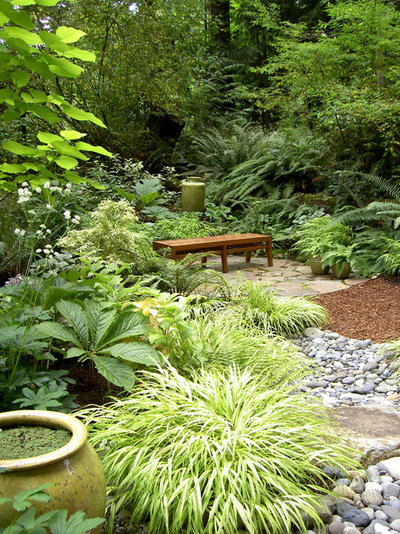
Bliss Garden Design
This is a very shaded area, and the far corner gets little to no sun. The foreground gets some filtered afternoon sun for just a couple of hours, so all the plants have to be shade tolerant.
This is a low-lying, fairly wet environment, and while a few of these plants can take drier conditions, most need consistent moisture.
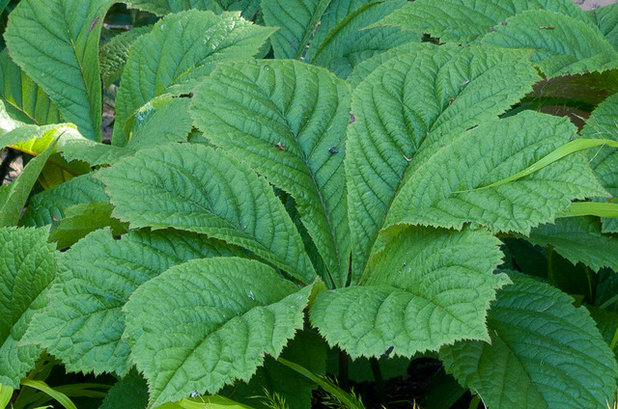
Le jardinet
How to Get the Look1. Start with a showstopper.Rodger's flower (Rodgersia pinnata) has bold, crinkly leaves that measure over 12 inches across, creating a spectacular backdrop for the dramatic plumes of creamy pink flowers that appear in midsummer. In early fall the foliage turns a reddish bronze.
The foliage of this perennial feels rough to the touch, with stiff bristles along its stem, making it unpalatable to deer. While making a perfect understory to taller trees and shrubs, its upright habit allows for companion planting at the base.
USDA zones: 5 to 9 (find your zone)
Water requirement: Constantly moist soil
Light requirement: Partial shade
Mature size: 3 to 4 feet tall, and wide with 3-foot flower spikes
When to plant: In spring or fall
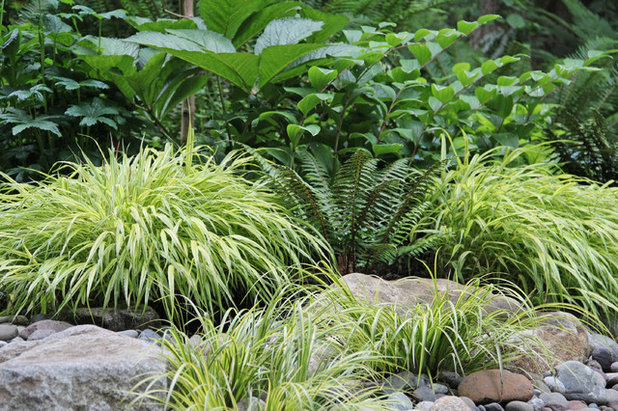
Bliss Garden Design
2. Add contrast with grasses.A blend of two soft yellow grasses has been used along the path and creek bed.
Fan-shaped
golden variegated sweet flag (
Acorus gramineus 'Ogon') is an evergreen grass that will tolerate exceptionally wet conditions — even standing water. Seen in the foreground, it has blades much stiffer than those of its partner here, Japanese forest grass.
The soft mounds of
Japanese forest grass (
Hakonechloa macra 'Aureola'), seen behind the sweet flag, are the perfect contrast to the taller Rodger's flower, forming a gentle golden waterfall that begs to be touched.
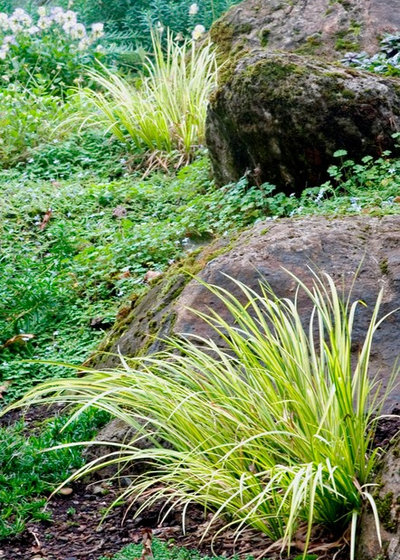
Monrovia
Botanical name: Acorus gramineus 'Ogon'
Common name: Golden variegated sweet flag
USDA zones: 5 to 9
Water requirement: Moisture retentive or wet soil, or even shallow water
Light requirement: Partial or full shade
Mature size: 1 foot tall and wide
When to plant: In spring or fall

Monrovia
Botanical name: Hakonechloa macra 'Aureola'
Common name: Japanese forest grass
USDA zones: 4 to 9
Water requirement: Moisture-retentive soil
Light requirement: Partial to full shade, but it will be greener in full shade
Mature size: 2 feet tall and 3 feet wide
When to plant: In spring or fall
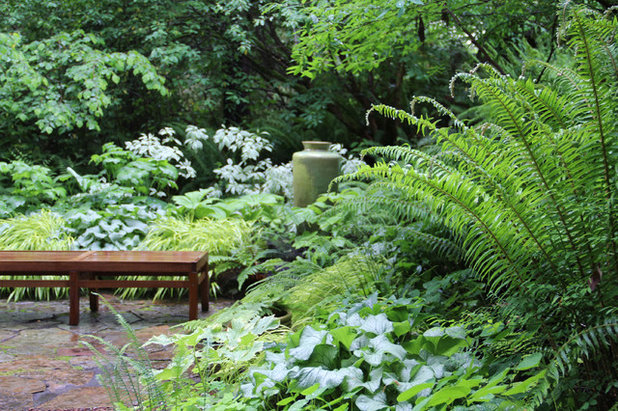
Bliss Garden Design
3. Add structure with ferns.Several Pacific Northwest native ferns have been used in this garden to provide a range of heights and textures.
The boldest of them all, seen in the foreground above, is
sword fern (Polystichum munitum). Although evergreen, it benefits from having its coarse foliage cut down in spring to make room for fresh growth. Cutting is worth doing, just to enjoy watching the fronds unfurl.
USDA zones: 3
to 8
Water requirement: Adaptable to a wide variety of soils, from dry to moisture retentive
Light requirement: Partial or full shade
Mature size: 4
feet tall and 6 feet wide
When to plant: In spring or fall
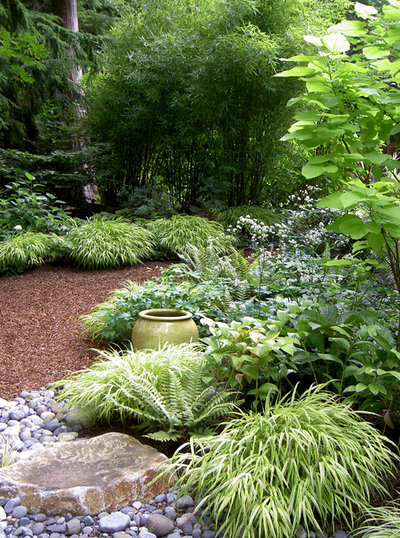
Bliss Garden Design
4. Add some taller highlights.To add interest at eye level, bring in some bright foliage.
Golden catalpa (
Catalpa bignonioides 'Aureum'), seen at the right, can be allowed to grow as a midsize tree or cut back hard in spring to keep it as a large shrub. Either way, its large, heart-shaped leaves make a great contribution to this combination. These open with a red flush but quickly turn to a vibrant acid yellow.
USDA zones: 5
to 9
Water requirement: Adaptable to different soils, from fairly dry to moisture retentive
Light requirement: Full sun (once established) to partial shade
Mature size: 15
feet tall and wide as a tree, or 6 feet tall and wide if cut back in spring
When to plant: In spring or fall
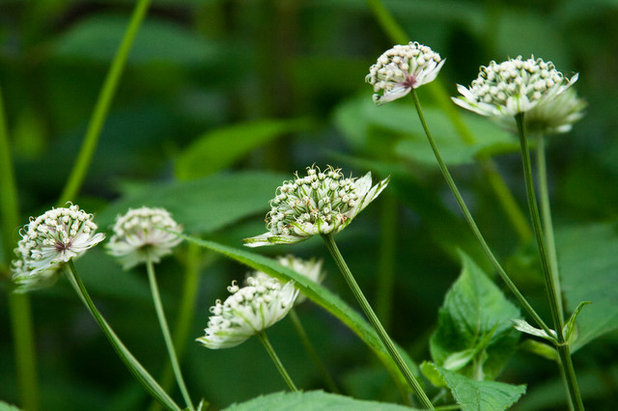
Scott Weber
5. Finish with a few flowers.This beautiful combination really needs no flowers — the beauty is in the juxtaposition of fabulous foliage. However, the early-blooming perennial
masterwort (
Astrantia major 'Alba') offers both a new leaf shape and white, pincushion-like flowers that add a little sparkle to the spring display.
USDA zones: 6
to 9
Water requirement: Adaptable to different soils, from fairly dry once established to moist but well drained
Light requirement: Full sun to partial shade
Mature size: 2 feet tall and wide
When to plant: In spring or fall
More: Houzz guides to flowers and foliage





